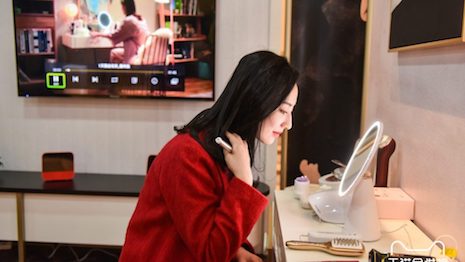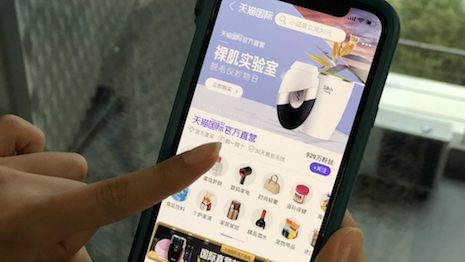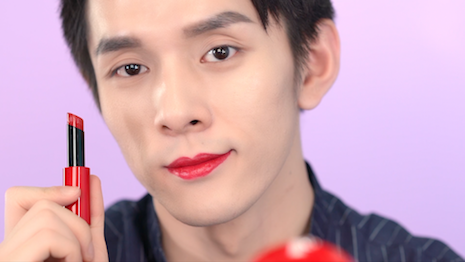 Chinese beauty brands are becoming more popular and prestigious. Image credit: Alibaba
Chinese beauty brands are becoming more popular and prestigious. Image credit: Alibaba
As the Chinese government and retailers push customers to buy from local brands, C-beauty is on the rise, according to research from Gartner L2.
Chinese beauty labels are leveraging national pride in their marketing, helping them gain traction with consumers, particularly around cultural holidays such as Lunar New Year. Following the wave of K-beauty and J-beauty brands from South Korea and Japan, C-beauty is finding an audience, particularly in digital channels such as Alibaba’s Tmall.
“C-beauty brands are not just being seen as cheaper alternatives to expensive European or Japanese brands, but are gaining higher prestige in the China market,” said Liz Flora, editor of Asia Pacific research at Gartner L2, New York. “More and more Chinese brands are actively promoting the fact that they are Chinese in their product descriptions.
“It’s only a matter of time that C-beauty will follow the global expansion of J-beauty and K-beauty,” she said. “We’re already seeing China-inspired beauty fads like the popularity of jade face rollers in the U.S.”
Online optimization
Search is one of the most important ways to reach Chinese consumers digitally. Using the right hashtags to point to trendy ingredients can help brands get discovered.
For instance, skincare is getting more scientific, with Baidu searches for cosmeceutical ingredients more than tripling in recent months.
Showing the rise of sophisticated skincare, three-quarters of serum sales on Tmall are cosmeceutical, meaning they claim to have medicinal benefits.
Beyond skincare, search is often how consumers find brands.
 How brands present themselves on Tmall is important. Image credit: Alibaba
Part of the rise of Chinese labels is tied to how they promote themselves on Tmall via keywords. While only 38 percent of C-beauty brands pointed to the fact that they were made in China in 2017, 72 percent leveraged China-centric keywords in 2018.
Showing the growing interest in Chinese-made beauty, half of the brands sold during Chinese New Year on Tmall were local labels.
National pride is also evident in marketing. Responding to the popularity of historic-themed television series, brands are launching products and efforts that nod to Chinese culture.
This imperial approach has also been used by Western labels. France’s Guerlain developed a social media campaign using characters from the show “Story of Yanxi Palace,” for which it provides the lip color. This resulted in a boost to the brand’s Tmall sales.
Consumers’ interest in entertainment is an opportunity for beauty brands, as viewers attempt to recreate the looks worn in their favorite television shows.
“Foreign brands face a challenge in adopting Chinese elements without cultural missteps, but Guerlain’s success at marketing its sponsorship of the hit show ‘Story of Yanxi Palace’ shows that it can be done,” Ms. Flora said. “When the brand promoted its lipstick in connection with the show, it tapped into its own history by pointing out that it has been used by royal families across the world to demonstrate that the connection to the show is in line with the brand’s royal heritage.
“The collaboration with a highly popular, relevant entertainment property coordinated with promotions by the show’s actors helped generate huge online buzz and a sales spike for the brand,” she said.
According to previously L2 research, 84 percent of all premium beauty brand engagement on Weibo is driven by posts featuring celebrities.
Lancôme’s and Estée Lauder’s successful pop idol partnerships are part of what boosted the brands to the top of the firm’s “Digital IQ Index: Beauty China” rankings. In addition to mobilizing famous influencers, the smartest beauty labels are investing in their marketplace visibility and WeChat services (see story).
Male makeup
Chinese men are putting more effort into their appearance, but brands are missing out on opportunities to reach them.
Alibaba's Tmall has dubbed this the "Male Beauty Era," as social media and vlogging stars record their grooming efforts, which include everything from skincare to lipstick. In 2018, sales of male beauty products rose 54 percent, with makeup in particular rising 89 percent year-over-year.
How brands present themselves on Tmall is important. Image credit: Alibaba
Part of the rise of Chinese labels is tied to how they promote themselves on Tmall via keywords. While only 38 percent of C-beauty brands pointed to the fact that they were made in China in 2017, 72 percent leveraged China-centric keywords in 2018.
Showing the growing interest in Chinese-made beauty, half of the brands sold during Chinese New Year on Tmall were local labels.
National pride is also evident in marketing. Responding to the popularity of historic-themed television series, brands are launching products and efforts that nod to Chinese culture.
This imperial approach has also been used by Western labels. France’s Guerlain developed a social media campaign using characters from the show “Story of Yanxi Palace,” for which it provides the lip color. This resulted in a boost to the brand’s Tmall sales.
Consumers’ interest in entertainment is an opportunity for beauty brands, as viewers attempt to recreate the looks worn in their favorite television shows.
“Foreign brands face a challenge in adopting Chinese elements without cultural missteps, but Guerlain’s success at marketing its sponsorship of the hit show ‘Story of Yanxi Palace’ shows that it can be done,” Ms. Flora said. “When the brand promoted its lipstick in connection with the show, it tapped into its own history by pointing out that it has been used by royal families across the world to demonstrate that the connection to the show is in line with the brand’s royal heritage.
“The collaboration with a highly popular, relevant entertainment property coordinated with promotions by the show’s actors helped generate huge online buzz and a sales spike for the brand,” she said.
According to previously L2 research, 84 percent of all premium beauty brand engagement on Weibo is driven by posts featuring celebrities.
Lancôme’s and Estée Lauder’s successful pop idol partnerships are part of what boosted the brands to the top of the firm’s “Digital IQ Index: Beauty China” rankings. In addition to mobilizing famous influencers, the smartest beauty labels are investing in their marketplace visibility and WeChat services (see story).
Male makeup
Chinese men are putting more effort into their appearance, but brands are missing out on opportunities to reach them.
Alibaba's Tmall has dubbed this the "Male Beauty Era," as social media and vlogging stars record their grooming efforts, which include everything from skincare to lipstick. In 2018, sales of male beauty products rose 54 percent, with makeup in particular rising 89 percent year-over-year.
 Men's makeup is becoming more popular in China. Image credit: Alibaba
Some brands, including Tom Ford and Chanel, have created lines or products that cater directly to men.
Chanel launched its first makeup products for men globally as more luxury cosmetic companies cater to male consumers.
While men have always been able to purchase cosmetics and skincare products, most luxury brands dedicate their personal care resources to female consumers. By appealing to men beyond masculine fragrances, Chanel can reach a new market and present a forward-thinking identity (see story).
Despite the fact that most beauty brands are fielding questions about male makeup on Tmall, only 45 percent offer products geared to men. An even smaller percentage actively market beauty to men.
Early adopters can therefore differentiate themselves, potentially gaining loyalty.
Men's makeup is becoming more popular in China. Image credit: Alibaba
Some brands, including Tom Ford and Chanel, have created lines or products that cater directly to men.
Chanel launched its first makeup products for men globally as more luxury cosmetic companies cater to male consumers.
While men have always been able to purchase cosmetics and skincare products, most luxury brands dedicate their personal care resources to female consumers. By appealing to men beyond masculine fragrances, Chanel can reach a new market and present a forward-thinking identity (see story).
Despite the fact that most beauty brands are fielding questions about male makeup on Tmall, only 45 percent offer products geared to men. An even smaller percentage actively market beauty to men.
Early adopters can therefore differentiate themselves, potentially gaining loyalty.
"Young professional men are investing more in beauty and grooming worldwide, and China is no exception," Gartner L2's Ms. Flora said. "Asia is actually at the forefront of this trend. Chanel chose South Korea as the first location to sell its men’s makeup line and then later launched it in China via a WeChat pop-up shop and on its brand site.
"Kiehl’s is one example of a brand that has successfully invested in marketing to the male consumer online in China, offering separate male categories in its Tmall store and on its WeChat mini program for gifts," she said. "It also markets its male collection with a dedicated Chinese brand ambassador and features male care Q&A content on Tmall.
"Since 91 percent of beauty brands have received questions on their Tmall shop asking if products are suitable for men and only 45 percent actually sell male products, brands without a dedicated men’s collection could become more inclusive toward their male shoppers with product categories, content, brand ambassadors and customer service options."
